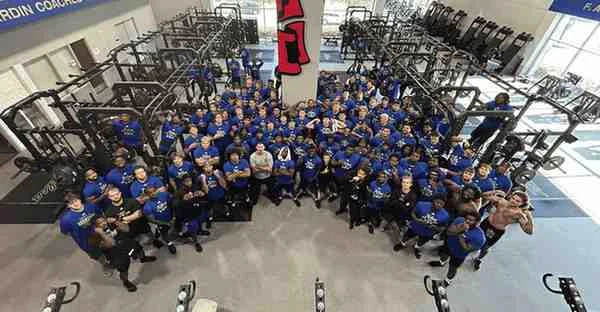[mashshare]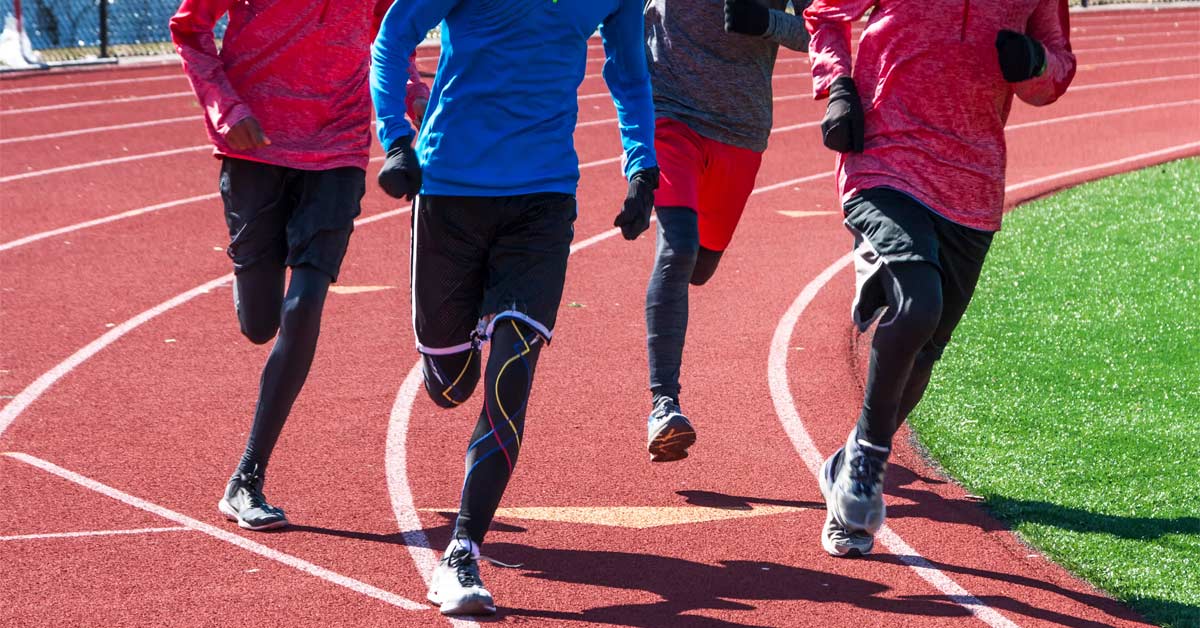
For the past three years, I have posted a list of messages that our track and field staff uses to get athletes of other sports to consider joining our program. My friend Tony Holler once told me, “Every high school has a good track team.” I think this is true, but coaches have various obstacles that may make it difficult to form the best track team possible. No matter what our situation is, WE need to be champions of promoting what our sport has to offer.
No matter what our situation is, as track and field staff we need to be champions of promoting what our sport has to offer, says @HFJumps. Share on XMy hope is this article gets shared with as many current non-track athletes as possible. Ideally, one or more points will resonate with them, and they will choose to give track and field a chance. I know athletes who choose to become part of the program at Homewood-Flossmoor High School will reap a lifetime of rewards for their choice, and I feel it would be the same at many programs throughout the world. Here are 11 ways that joining track and field will benefit athletes, no matter what their sport.

Track and field will help you improve the measurable that matters most—speed.
I played football for 11 years. I coached it for five. I never heard a coach say, “Great tackle, but next time, please get to the ball carrier slower.” In the world of high performance, speed is king. Smart track coaches realize the vast majority of events are speed-based (14 of 18 in Illinois) and design training to ensure speed is maximized. This means that, outside of competitions, training is designed around short (60 meters or less) but maximum sprint efforts followed by full recovery.
If your school’s track program has an electronic timing system to time short sprints in practice, there is a high probability the coaching staff values and cultivates speed. Furthermore, when you improve your maximum speed, your ability to accelerate will improve as well. Wouldn’t you like your first few steps in your primary sport to be faster? Get out on the track and fly!
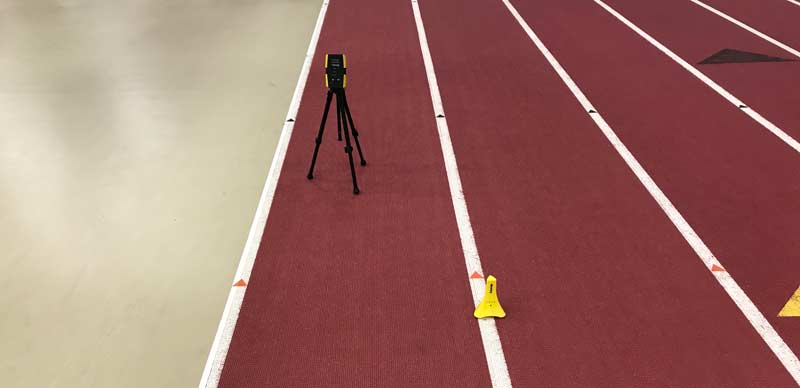

Track and field also improves other important measurables, such as strength.
Are you worried that being on the track will not allow you to get stronger? You shouldn’t be. Knowledgeable track coaches recognize the importance of strength, and they devote time to addressing it both inside and outside of the weight room.
One of my favorite stories which addresses this deals with a former football player at our school. During his freshman and sophomore years, he trained with our football team in the weight room in the off-season. I was able to convince him to come out for track his junior year. About midway through our season, he told me, “Coach, I haven’t been squatting as often as I did during football lifting, but I am able to squat more weight.” I asked him what he was doing more of since he joined track. His one-word answer: “Sprinting.”
One of the most overlooked advantages of sprinting is that it is an incredible strength exercise, says @HFJumps. Share on XOne of the most overlooked advantages of sprinting is that it is an incredible strength exercise. Forces put into the ground when sprinting are between two and five times body weight, on one foot, in a tenth of a second. For a 200-pound athlete, that is between 400 and 1,000 pounds of force! Former NFL strength coach Buddy Morris may have said it best: “Sprinting drives up your weights. Weights don’t necessarily drive up your sprinting.”1
The reality for most athletes at the high school level is the best strength and speed improvements will come from a program that includes sprinting, jumping, throwing, and resistance training. This will make you a more explosive athlete, which transfers to all sports. Your high school track team has all of this, at a low cost, in a competitive atmosphere!

Your track coaches are the best people in the school to help you improve the most important measurable (speed).
Track coaches have the luxury of not having to worry about game-play strategy, in comparison with a field or court sport coach. Because of this, we get to focus our professional development time on researching how to get people to run faster, jump farther and higher, and throw farther. This not only includes training system design, but also the study of the technique, which allows for better performance in these general athletic movements. Joining track and field will give you the opportunity to become a better-moving human, which you can apply to all land-based sports.
In an effort to keep things real, I will say something that may ruffle some feathers. There are coaches of field and court sports who have every right to discourage athletes from going out for their school’s track team. If I coached football, and I knew the track coach had every athlete start and finish every practice with a 2-mile jog, it would be hard for me to endorse that program.
Joining track and field will give you the opportunity to become a better-moving human, which you can apply to all land-based sports, says @HFJumps. Share on XUnfortunately, like any other sport at the high school level, there are track coaches with questionable methods. The reasons for this vary, but some items to look for and avoid can be found at the end of Tony Holler’s “Can Your Kid Sprint?” article. I’m proud to say I am part of a program that coaches of other sports should endorse, and I feel that, through the educational efforts of many, fewer and fewer track programs fall in the “discouraged” category.

We don’t just get people faster. Everything we do is tied to enhancing overall athleticism. Higher athleticism leads to greater adaptability.
Yes, you will get faster by joining track and field, and that alone will make you a better athlete. However, another part of this journey involves challenging your coordination. Every. Single. Day. The coordination challenge you will face will be different than in field and court sports. The environment may be less dynamic, but the demand for precision is higher. This will cause you to develop an awareness of your body that you’ve never had before.

In field/court sports, your teammate(s) can bail you out. This doesn’t exist in track and field, and because of that, you will become a better competitor.
You can’t just pass the basketball to your best player and get out of the way. Touchdowns still occur even when a block is missed. Relays are seldom won in track and field if a baton is dropped. When you step up to the starting line, you control your destiny. When your name is called at the long jump runway or shot put ring, you control your destiny. No one else can step in and compete for you. It is you against the world, and this is a big challenge. However, it can bring out the competitor within. Your inner warrior. Not your Instagram persona or your video game avatar—your real-world inner beast mode.
Digging a little deeper into this, the inability to be bailed out either terrifies or excites you. If it excites you, it only makes sense to feed your desire to compete. If this scenario terrifies you, you need track and field to learn how to execute under pressure. It is, without a question, a skill you can develop with practice.
Most track & field events are solo, so when you step up to the starting line, you control your destiny. If this terrifies you, you need track & field to learn how to execute under pressure. Share on XI know this because I am a person who falls on the terrified end of the spectrum. My genetic make-up lends me to getting overstimulated in high-pressure situations. Growing up, I played whichever sport was in season. There is no question that exposure to situations that demanded execution on the field of play transferred to my ability to execute in the real world.
During the first speech I gave in my freshman year of high school, I shook so badly the audience may have thought I was having a seizure. Now I speak in front of people every day as a teacher and have presented numerous times in front of my peers. I would not have had the courage to do this without the experiences I had in athletics. These types of experiences do not happen in an off-season weight room program—they happen in competition.

There is no substitute for competition, and every event of every meet you compete in is similar to a game-winning drive/possession.
High school football games average 150 plays (including special teams). While there is pressure to perform on every play, there are situations that are more pressure-packed than others. If an offense runs 60 plays during a game, my guess is about 30% carry more weight than others (3rd downs, drives at the end of half/regulation, etc.). However, if the score is not close, the pressure in some of these situations will decrease.
In track and field, every event in which you compete is pressure-packed (event competition opportunities range from 50–200, depending on event participation). Part of this is because you are responsible for your results, as mentioned in the previous point. The other is that your main competition is not an opponent—it’s the stopwatch or tape measure. While you may win some battles against them along the way, you can always make improvements, so your competitor will always win the war. This can be frustrating and humbling, but it’s also an incredible opportunity because it can get you to achieve results you didn’t think were possible!

Many college coaches prefer multisport athletes.
I don’t make it through more than a couple of days without seeing a piece of information that promotes youth athlete participation in multiple sports. This does not mean playing multiple sports at once, but playing different sports throughout the course of the year (think soccer season, basketball season, track season). Creating a broad range of coordinative abilities, which comes from playing different sports, allows for athletes to reach a higher athletic ceiling—a clear desire of college coaches.
Possessing a broad range of coordinative abilities, which comes from playing different sports, allows for athletes to reach a higher athletic ceiling—a clear desire of college coaches. Share on XServices such as Tracking Football are at the forefront of using data to define athleticism. They put out graphics on a regular basis, such as the one below that shows their athleticism metric (PAI) along with the amount of multisport participation each team has.
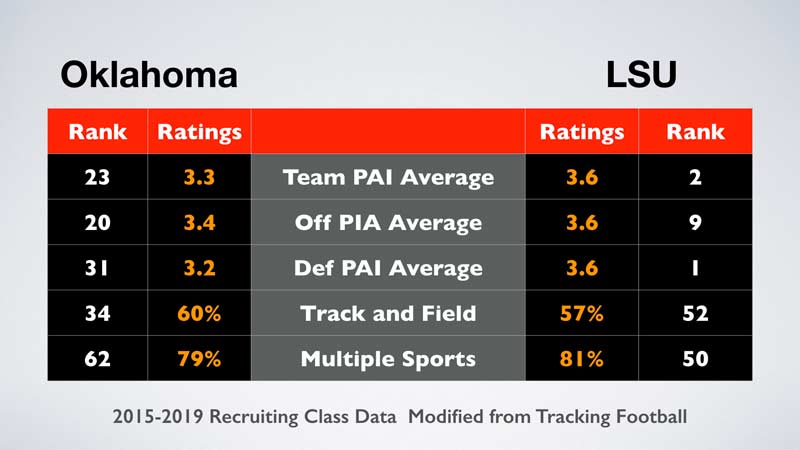
Athleticism is important to college coaches, but the intangible it seems most coaches like about multisport athletes is their exposure to competition. College coaches want to know if they are recruiting elite competitors. Playing more than one sport creates more opportunity to compete. An individual sport with a team component like track is a great place for this exposure. Iowa State head football coach Matt Campbell summed this up wonderfully at a press conference in 2019:
“You can’t compete in a weight room. You can’t go and compete with a trainer, even though everybody is telling you to go do that. But you can’t. When you’re competing is when you’re winning and losing, and you’re figuring out a way to win. That’s what track teaches. It’s what wrestling teaches you. It’s what basketball teaches you. It’s what baseball teaches you. So, to me, that is a huge piece to our recruiting process because it gives us at least one answer to the intangible that’s really important: How do you compete? How do you act when things don’t go well? How do you respond to adversity? We get to see it live and in color, and those things are really, really important to our staff, at least in our evaluation of a young person coming here.”

By playing another sport, you will have more people in your corner helping you achieve your goals. In this world, there is always room for more support.
Most coaches love interacting with athletes, and when a solid coach-athlete bond is created, it is special. I’ve cried countless tears of joy and happiness with the athletes I’ve had the privilege of coaching. Coaches will do anything to help their athletes in the game of life. Heck, I recently spent a sizable chunk of change on a set of knives I didn’t need to support a former athlete.
Coaches will hold you accountable for your effort on the field/classroom, will provide you with emotional support when you need it, and can be a lifelong resource after you graduate. Don’t we all need another person like this in our life?

You will be coached by the same people during the time of your participation.
Track and field is one of a handful of high school sports that allows you to be coached by the same people each year. Most field and court sports are split into different levels with different coaches. Track tends to be divided by event area. For instance, I work with all of our long/triple/high jumpers, freshmen through seniors.
Track and field is one of the few high school sports where your coach is often the same each year. This creates consistency in your athletic development, says @HFJumps. Share on XBecause of the additional time you will spend with your coach, there is a better chance of a stronger relationship developing. It also creates consistency in your athletic development. The first year is a learning experience for both coach and athlete, but after that, the track coach knows your strengths and weaknesses and can identify the best route to take for you to reach your potential.

You get to practice with freshmen through seniors. This provides numerous opportunities to learn and lead!
One consistent occurrence each year is the current crop of seniors talking about “These freshmen _____.”
- “These freshmen don’t pay attention.”
- “These freshmen are immature.”
- “These freshmen disappear during tough workouts.”
This is always an entertaining situation because it gives our coaches an opportunity to take a stroll down memory lane when the current seniors were “These freshmen.” After a few stories, the importance of being quality role models (the way former upperclassmen were for them) is reemphasized.
As a coaching staff, we constantly remind our young athletes to learn from our veterans. There is also an expectation for our veteran athletes to serve our underclassmen. The first step to this mentorship is treating the underclassmen like gold. Servant leadership is lifelong, and any chance to practice it is a great opportunity.

There is something special about wearing your school’s uniform.
I had the fortune of being able to participate in football (one year) and track and field (four years) at the collegiate level (NCAA Division 3). I really enjoyed the experience, but it just was not the same as the experience I had in high school.
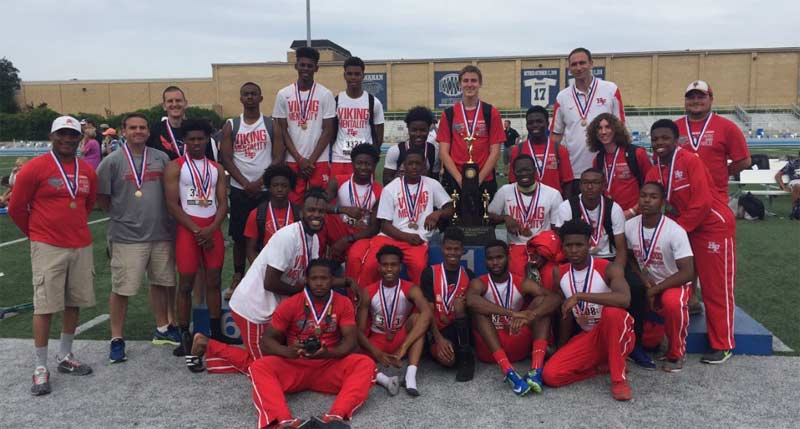
Donning the high school uniform is a culmination of the 10 years of athletic competition you experienced in your community prior to high school. You know everyone on your team. You know a lot of the athletes you compete against. It is a sacred time. I am not saying the college experience won’t be great—it very well can be—but I can say with certainty that it will be different.
Take the Chance and Don’t Look Back
A quote often credited to both Wayne Gretzky and Michael Jordan is, “You miss 100% of the shots you don’t take.” When I was 16, my high school football coach told me, “I want you out on the track running 100s….FAST.” That was all he needed to say.
Little did I know track would end up being the sport I competed in through college, and the sport that I am now about to begin my 17th year coaching. I find it hard to imagine a life where I am not coaching track and field. If I hadn’t been willing to give it a shot in high school, I strongly doubt it would still be a huge part of my life today.
However, this is not about me. It is about you. YOU are the person in charge of defining YOUR high school experience. The best piece of advice I can offer you is to maximize your experience because you do not want to look back and think, “What if?”
Please share this article with anyone who is not involved in track and field. Hopefully, it will get them to consider participating!
Special thanks to Nate Beebe and John Hunter for their assistance in constructing this list and the content within. The same goes to Keith Whitman for his dialogue via social media and specifically point #11.
[freelap-share]
[mashshare]
References
Morris, Buddy (via @StuartMcMillan1). “Sprinting drives up your weights. Weights don’t necessarily drive up your sprinting.” 3:54 p.m.; 11 Nov. 2016.
Campbell, Matt. “The importance of multi-sport athletes.” Iowa State University. 9 Oct. 2019.




